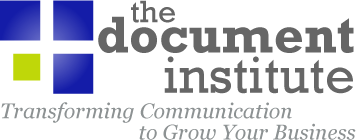Although invention and evolution has seen many changes to the print industry over centuries, over recent decades a major change has been the convergence of data service bureaux and commercial printers.
The Document Institute has many years working with businesses going through these challenges and we are continually surprised when we see people spending considerable time, effort, and money, on reinventing the weheel; researching and developing products and services that have been researched and developed to a little or large extent by others (often many) before them.
Whether it is through Education - including standard or tailored courses, or facilitated workshops - or by utilising our Consulting services - including Strategic Consulting to alleviate the need for Senior Management to lose focus from the business at hand - the Document Institute can help.
The trend of these changes started over 2 decades ago when traditional data service bureaux - typically with a line printer as an output device off the back of a mainframe - had customers who wanted to do with their documents. Document Owners started to realise that the essential mail - statements etc - they sent was in most cases the primary communication they had with their end customers. This lead to more personalised documents that had variable content and imagery based on profile or geographic data the company hasd about their customer, and then eventually into white space management and the use of actual customer pattern and usage data - what would be called transpromotional. Printers were now printing page based documents rather than dot-matrix like line-mode and graphic designers were not only getting involved in the design of the base pre-printed stock, but also the variable content too. As the years progressed, variable colour was requested by customers and as the vendors technology adapted with these needs, prices reduced and was more accessible to more Document Producers and other Service Providers.
This trend manifested itself in another way too, Commercial Printers were getting into digital printing. Initially they were seeking cost offective optins to do quick turn around, shorter run static print jobs, compared to the plate creation and the other decent time based requirements involved with offset printing. They now had full colour digital printers that enabled them to do very small quantities with minimal start up times, but they wanted to do more and started getting into data printing. Initially this was as simple as a name on a book or a calendar or th elike, however as their experience and confidence grew, some migrated into data-driven direct mail.
The convergence was nearly complete, commercial printers and data print & mail service bureaux were now both printing and mailing variable data-driven documents on full colour digital printers.
Now we see businesses - regardless of which side of the original fence they came from - wanting to expand their services to involve more of the other. Data service bureaux looking at doing significantly more high quality colour work, and commercial printers wanting to do more complex data-driven document creation. And both are now creating or looking at creating electronic versions and cross-media campaigns to complement their print.
This trend is not only to value add to existing customers, but also to step out of the commodity market that many businesses see the print industry to be.
This is a long journey and you don't have to do it alone. Most companies are at one of the many different points along the above and similar journeys. If you would prefer to involve pepole who have done it before to give you a guiding hand, please contact us.

